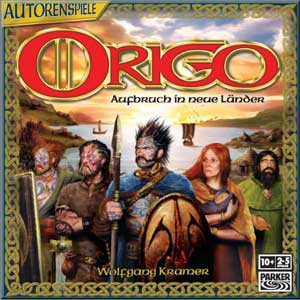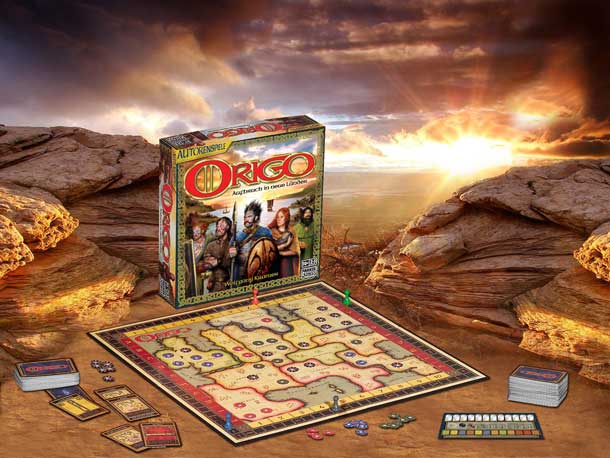Pevans
OrigoReviewed by Pevans |
 This is a game that I probably wouldnít have come across if it wasnít one of the games for this yearís EuropeMasters tournament. Not because of the designer Ė any game with Wolfgang Kramerís name on it has to be worth trying Ė but because itís published by under the Parker label by Hasbro Deutschland. Itís a German-only edition and itís unlikely that the US or British arms of Hasbro will produce an English version of what is an out-and-out strategy game. Thatís a shame.
This is a game that I probably wouldnít have come across if it wasnít one of the games for this yearís EuropeMasters tournament. Not because of the designer Ė any game with Wolfgang Kramerís name on it has to be worth trying Ė but because itís published by under the Parker label by Hasbro Deutschland. Itís a German-only edition and itís unlikely that the US or British arms of Hasbro will produce an English version of what is an out-and-out strategy game. Thatís a shame.
For some reason the game feels old-fashioned to me. This may be because of the colour scheme and faded colours, but itís also because the game is played on a square grid. The board is a distorted map of Europe roughly divided into Ďcountriesí and seas to fit the square grid. Each player has a set of round counters to place in the squares and a scoring pawn in their colour. The pawn goes on the track round the edge of the board, with the first player at the back. There can only be one pawn on a space, so landing on another pawn gives you an extra point. However, this doesnít seem to have a big effect on the game.
Depending on the number of players, each starts with a certain number of counters and places a specific number on the board, one at a time, to start the game. Then the game starts and players can place more counters on empty spaces by playing a card. Cards indicate a specific country, row or column in which to place a piece. Or they can be a ship, allowing the counter to be placed in any sea, or ĎPopulation expansioní to expand from an existing position.
As more counters are placed, countries fill up. When the last square in a country is filled, it is Ďestablishedí and a neutral pawn is taken off the turn track and placed on the country. The player placing that last counter scores the victory points revealed by the removed pawn. These points climb gradually from 3 points to 8 for the twelfth and last country. The fourth, eighth and twelfth spaces are coloured red. At the end of a round in which one of these has been revealed, scoring takes place.
Players score points in three different ways. First, they get points according to the largest Ďclansí on the board. A clan is a group of counters adjacent (not diagonally) to each other. Ties score the next position. That is, players who are tied for first score the second place points. This applies to all the points scoring. Second, players get a point for each counter in a sea space (a ship) with a small bonuses for the players with the most and second most ships. Finally, they get points for the most, second most and third most counters in each country. The value of each country depends on how big it is, but with twelve countries on the board, there are a lot of points to be picked up here.
However, I havenít finished describing a turn yet. Once a country has been established, pieces inside the country can be attacked. Players do this by playing a card that allows them to place a counter on the square theyíre attacking. The defending counter and orthogonally adjacent counters count as a point for defence or attack, as appropriate. The defender then plays cards. Each card played is worth two points and the attacker wins if they have a bigger total. The two protagonists continue adding cards until one gives up. The loser loses their counter; the winner takes the spot.
In their turn, players can attack twice or expand twice (or attack once and expand once). They also have one Ďmigrationí move. This allows a piece on the board to move from a land space to any adjacent empty space. If itís part of a clan, it can move to any empty space adjacent to any part of the clan. Players can also move all of their ships (counters on sea squares) in the same way. This is very powerful. A player with a lot of ships is in a threatening position Ė provided they have a chain along which to deploy them. Even without any ships, a player can establish a country with three empty squares (and the smallest countries are only four squares) by playing two cards and migrating a counter.
Players can do these actions in any order, which gives them a lot of flexibility. At the end of each playerís turn, all players make their hand of cards back up to size. This ensures that a player whoís had to defend against one of their opponents isnít disadvantaged if another one attacks them. The game continues until all 12 countries have been established or any player runs out of counters (which hasnít happened in any of the games Iíve played so far).

This is a relatively simple strategy game that appears to be a cut down version of Kramerís earlier Wildlife. It is none the worse for this. It makes for a simpler game that plays quickly and rewards players who think strategically and tactically. So far, Iíve seen two major strategies: building a single large clan or having several clans around the board. The first should make sure of the maximum points for the largest clan. It also allows the players to get the majority in several countries. The alternative approach picks up points for having a presence in lots of countries. Particularly at the first scoring, players can have the largest stake in a country with only one or two counters. However, this is more vulnerable to attack.
The tactical points are about making good use of migration and ships. My problem with ships is that placing a ship is a wasted opportunity elsewhere on the board, even if itís tactically useful later. However, migration can be very useful. In particular, having established a country, a player with a majority can migrate counters out of it without jeopardising their points and make use of them again. Interestingly, as thereís plenty of room on the board and players have a limited number of counters, attacks play a relatively minor role in the game. There are usually done for specific strategic or tactical reasons Ė such as breaking up an opponentís large clan.
This is an excellent medium-weight strategy game. It provides strategic and tactical options and forces players to plan and decide between their options. It works well with four players, providing an even contest. The only surprise is that itís published by Parker. It gets 8/10 on my highly subjective scale.
Origo was designed by Wolfgang Kramer and is published by Parker Spiele. It is a strategy board game for 2-5 players, aged 10+ and takes about an hour to play. It is only available in German, but a translation of the rules is available on Boardgamegeek.
This review was first published in To Win Just Once 79, October 2007.